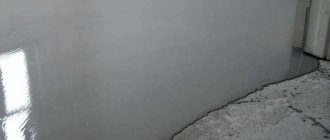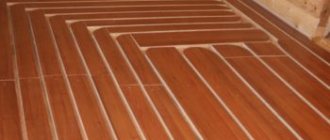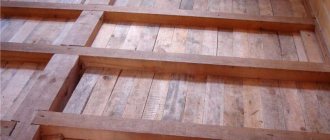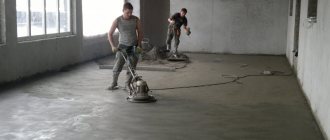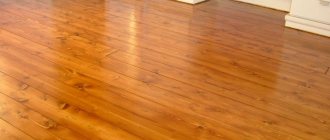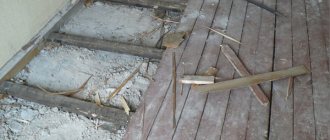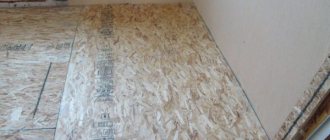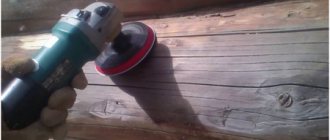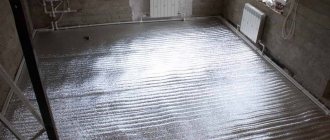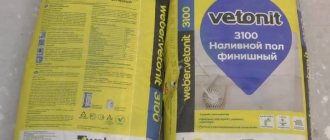In the process of carrying out repair work, preparatory activities occupy a special place. One of them is grinding the concrete floor. It is used to remove the old layer, level the surface and prepare it for decorative finishing by painting, varnishing or finishing with polymer-based coatings. Polished concrete floors are widely popular in retail and warehouse premises, in public premises with high traffic - educational institutions, theaters and hotels, in utility and even residential premises. In other cases, by grinding the concrete, it is possible to properly level and prepare the base for laying the floor covering.
Sanding concrete floor
Concrete and its properties
Thanks to its unique operational and technical characteristics, concrete has become widely used in various construction industries. It is concrete that often allows you not to limit your imagination in implementing the most unusual and daring architectural solutions. Concrete structures have the highest strength, durability and withstand any operational impacts.
Concrete mortar
Concrete is used in construction in the following form:
- As the main building material, concrete is used in the manufacture of foundations, floor slabs, enclosing and other structures.
- As a fixing solution for fastening building blocks and other elements.
- As a filler.
- As an insulating material.
- As a finishing material.
Note! When producing concrete, it is possible to adjust its basic properties in order to match the composition to operating conditions. For this purpose, various additives and composition manufacturing technologies are used.
The process of creating a concrete base
Products, structures and surfaces made of concrete are reliable and durable. The plasticity of concrete mortar allows you to create seamless monoliths of any shape. True, when pouring a large area (for example, in a warehouse), it will be necessary to provide compensation gaps (seams). A seamless concrete floor has high hydro-, sound- and heat-insulating properties, which allows significant savings on additional insulating materials and increases the comfort of a person’s stay in such a room.
Structure of a hardened concrete surface
By using additives with a water-repellent effect, it is possible to increase the water resistance of concrete. Therefore, it is widely used for the construction of structures used in the open air - retaining walls, bridges, dams, dams, water pipelines, wells, swimming pools, porches of private houses and public buildings. Unlike wood, concrete does not support the development of microorganisms in its structure.
Mosaic concrete floor is highly decorative
Concrete has an affordable price, so it is most often preferred, and its wide range of applications allows it to solve a variety of construction problems.
Monolithic slab
A monolithic slab is the most reliable foundation.
It involves pouring and forming a monolithic concrete block with metal reinforcement inside. The specific design ensures the “buoyancy” of the entire structure. A garage built on a floating slab base is protected from changes in ground level and, accordingly, from destruction of the walls.
The slab base is shallow, but unlike tape, in this case the entire floor area is reinforced.
There are several types of monolithic foundation:
A continuous horizontal fill is arranged for rooms without a basement or plinth: the upper surface of the slab is the basis for laying the floor covering. A ribbed slab is poured along the perimeter of a monolithic strip (or as intersections), the height of such a ribbed fill is equal to the level of the plinth. Pouring a box means that the walls are continuation of the base, and have common reinforcement.
The height of the ribs is displayed at the floor level. Floor slabs are laid on top of the ribs. This method maximizes the area of load distribution.
Typically, the foundation slab is poured for garages in which it is not planned to install an inspection pit. But if the type of soil allows it, you can lower the filling level to the height of the basement or inspection hole and bring the ribs to the level of the soil surface, arranging an overlap over them.
Purpose of grinding
In the context of modern trends in which the construction industry is developing, the distribution and popularity of concrete floors is not inferior to other coatings. Moreover, concrete floors are relevant for some interior styles - loft, grunge and other industrial styles.
Loft style interior
Expert opinion
Afanasyev E.V.
Chief editor of the pol-exp.com project Engineer.
Thanks to grinding, the concrete surface acquires an aesthetic appearance and a lot of positive qualities. Polished concrete floors have the following advantages:
- Simple and affordable maintenance to keep the surface in working condition.
- Reliability, high strength and long service life.
- Excellent compatibility with most finishing materials.
- Versatility - such floors are used both indoors and outdoors.
- Waterproof and resistant to chemicals.
- High mechanical strength and resistance to abrasive loads.
Concrete floors that have gone through the grinding stage are found in commercial, warehouse, and industrial buildings; they can be found in office buildings, educational or medical institutions, and in the lobby of a station. Such floors are equally popular in multi-storey and private housing construction, in the design of courtyard areas, in the arrangement of garages and utility buildings.
Interior of a modern store
Note! Mosaic concrete floors are especially decorative when decorative chips and coloring pigments are added to the solution. In this case, it is possible to create not only solid surfaces, but also colored patterns. Sanding such a floor is one of the final stages.
The first grinding is carried out 5 days after pouring the concrete solution. The final one is performed after the concrete base is completely ready, that is, after its final hardening.
Dry grinding method
Note! Cement laitance appears on the surface of a new poured concrete floor, which must be removed before grinding. When working with an existing concrete surface, it is sufficient to remove the old concrete layer by grinding.
Operator control of a self-propelled machine
Using grinding, you can not only eliminate unevenness, but also remove other defects and contaminants. Regardless of how long ago the concrete floor was made, grinding it transforms the surface, looks fresher and has better adhesive properties.
As a result of grinding, the concrete surface becomes suitable for applying any material that requires a perfectly flat base. For example, self-leveling floors require a responsible approach to preparatory measures, during which the base is ground and damaged areas of the upper concrete layer are removed.
Also, a surface that has been damaged by grinding is restored, the damaged layer is removed, and the surface acquires improved performance qualities.
Hand-held devices allow you to treat hard-to-reach areas
It is worth remembering that untreated concrete can absorb moisture, which over time will lead to its destruction. Grinding can solve this problem and increase the water resistance of the concrete surface.
Important! Grinding should not be taken as a salvation from any imperfections in the concrete surface. If the floor is uneven, has waves and significant differences in height, then the grinding machine is powerless here, since it moves very close to the floor surface and requires its evenness.
If the concrete surface is polished after the grinding stage, then such a floor is used as a finishing coating. In particular, this includes the previously mentioned mosaic concrete floors. If polishing is not expected, then the concrete floor retains its roughness and is treated with impregnations, protective and decorative coatings.
Grinding is required when it is necessary to renew an old concrete floor when it has been subjected to high wear and tear with freezing and thawing of water that has entered the concrete structure, during which the destruction of the top layer has occurred. By removing such a layer, you can get a renewed, durable surface, eliminating the complex repair work of pouring a new screed.
Mosaic floor in a warehouse
It is worth noting that any concrete coating can be subjected to grinding, regardless of the time of its manufacture. Moreover, if this type of processing is planned, then this fact is taken into account when manufacturing the working composition.
With the help of multi-colored fillers and dyes, mosaic floors are unique in their design
The function of filler in concrete in the manufacture of mosaic coverings is performed by fine crushed rock. It is worth taking a responsible approach to the choice of filler: if its density is too high, abrasive finishing will be difficult, and low density will reduce the strength of the coating. Thus, floors with marble chips are easier to sand than those containing granite or gravel filler. Fine marble and granite chips allow you to create aesthetically attractive concrete surfaces after they are ground and polished.
Floors made from marble chips are widely used to create floors in shopping and office centers, theaters, museums, warehouses, industrial and even residential premises. Read in detail about the process of installing mosaic floors made of marble chips in a special article.
Polishing technology for restoring the top layer of an industrial floor
Polishing technology can be used when restoring the top layer. The finished system can work on dusty, moisture-intensive industrial floors (including lastryko, terrazzo), which demonstrate low mechanical strength and insufficient aesthetics.
Processing begins with metal discs with low grain size, successively changing the grain level to a higher one. If repairs are required, use one- or two-component repair mixtures for concrete. When the defects are eliminated, the surface is cleaned.
A concrete care product, hardener and sealant are sprayed onto the dry base. The next step is processing with plastic grinding discs and polishing with diamond discs. The degree of abrasiveness is selected based on the required degree of gloss. At the end, the coating is treated with polishes and rubbed with natural wax discs.
Advantages of polished concrete floors
After sanding, the surface becomes smooth and even.
Floor grinding is carried out mainly using special installations called grinding machines. Surfaces that have undergone this treatment have the following advantages:
- A surface with increased strength and resistance to mechanical loads.
- Economical surface care and the ability to repeatedly restore the exposed concrete layer in order to renew and improve performance properties.
- Improving the appearance, increasing the aesthetics of the surface and the ability to create a decorative coating with colored patterns.
- Excellent compatibility with most finishing materials.
- Versatility of use and the ability to withstand a wide variety of operating conditions: high humidity, severe frost, chemicals and other adverse influences, both indoors and outdoors.
- Resistant to high loads from vehicles and equipment, high traffic.
Work must be carried out using personal protective equipment
Grinding with the help of special equipment is not a cheap type of work, but this is the only drawback that should not be a reason for abandoning these measures that increase the operational capabilities of a concrete floor. In addition, if you use a hand tool for grinding, then if you follow the basic technological points, you can do the work yourself, saving on the services of a specialist.
Scope of application
These floors are used:
- In administrative buildings.
- In production workshops.
- In warehouse premises.
- In supermarkets.
- In sports facilities.
- In cultural centers, exhibition halls, cinema foyers.
- In hotels, restaurants.
- As open areas under a canopy in a private house.
Concrete floor in a hangar
Grouting fresh screed
There is a special technology for working with fresh screed, which is practiced within 4-20 hours from the moment of pouring. It allows you to create durable, wear-resistant coatings for commercial and industrial facilities and even floors for open areas. For work they use a grinding helicopter - a special type of trowel. It is manual or self-propelled, equipped with a diesel, electric or gasoline engine.
This technology helps compact the top layer of the poured screed. First, rough cleaning of the concrete is done using cement-based toppings. After 10-16 hours, finish grinding is carried out with rubbing in dust-removing impregnations. For a decorative effect, toppings with added pigments are applied over the screed.
Beginning of work
According to the most common technology for grinding a concrete floor, this stage of work should begin from 10 to 15 days after the concrete is poured. It is during this time interval that the concrete has sufficient strength and the fractional fillers located inside it in the form of crushed stone, granite, gravel or marble chips are already securely fixed in the concrete mass, and during grinding they will remain securely in place.
Working with a compact tool will take longer
As previously noted, grinding is performed in several stages. The first can be performed 3–5 days after pouring concrete. During this period, the surface strength will already be sufficient so that protruding irregularities can be removed by grinding without “burrowing” too deeply so as not to disturb the position of the filler.
The effect of concrete processing by grinding
Safety precautions
To avoid injury and keep the instrument safe, you need to follow simple recommendations:
- Before starting work, inspect the device for damage, cracks in the housing, and reliability of wire insulation;
- put on protective clothing and shoes, gloves, goggles and a respirator in advance;
- ensure good lighting of the workplace;
- when replacing wheels and attachments, be sure to disconnect the device from the network;
- If vibration or a burning smell appears, stop grinding immediately.
If you strictly follow the technology, you can create a beautiful, monolithic and perfectly smooth floor with your own hands, which will not be inferior in strength to stone. Considering its wear resistance, long service life and ease of operation, it is probably worth mastering the simple technique and applying it in practice.
Processing options
Regardless of the structure of the concrete surface, one type of equipment is used for grinding it, suitable for working with concrete and stone.
Wet processing
There are two technologies: wet and dry. In the first case, it is a mosaic floor with marble or other types of filling. When carrying out the wet grinding process, abrasives are used that ultimately make it possible to obtain a surface that is perfectly smooth and shiny, as if the polishing stage had been completed. The disadvantage of this technology is associated with the formation of wet sludge on the floor surface during operation, which interferes to some extent with quality control of the actions performed.
Dry processing is associated with a high level of dust formation
The dry grinding method is more convenient in this regard, since the cement dust generated during the work can be effectively removed by connecting an industrial vacuum cleaner to the grinding machine. As a result, the quality of the work performed will be visible and the likelihood of mistakes will be reduced.
Preparation
In order for polished concrete to last a long time, its proper preparation plays an important role.
To do this, you need to take the following steps. First of all, dismantle the old coatings and check the evenness of the plane with a three-meter ruler. The presence of holes, potholes or bumps determines the degree of cup wear.
Then you need to examine the surface for the size of cracks, seams, etc. If available, seal them with any hand tool.
Before starting sanding work, you also need to tap the floor or walls for strength.
If it is missing, some areas will have to be refilled. At the same stage, complex work is performed, for example, diamond drilling of concrete
It is important to ensure the reliability of the power supply - any interruptions can have a detrimental effect on the outcome of the process
Important criteria in assessing the readiness of a floor for sanding are the absence of cracks, seams and other elements that could damage the delicate sanding tool.
Types of equipment
The choice of equipment is influenced by the frequency of its use and the area of the objects. In many construction stores you can find equipment from different manufacturers and capacities, both for domestic use and for professional activities when working on large facilities.
The drivers on which the grinding tools are attached move in opposite directions during the grinding process.
Undoubtedly, professional equipment is of a higher class and can provide better grinding results. Grinding machines of this level are distinguished by a planetary mechanism, represented by a large disk with auxiliary wheels equipped with diamond nozzles that carry out synchronous movement. At the same time, the floor surface acquires ideal evenness due to the complex trajectory of the diamonds when the wheels rotate in the opposite direction.
Mosaic Floor Grinding Machine
The essence of the design of the grinding machine is the presence of a rotating unit, with abrasive parts attached to it, which remove the top concrete layer and create a smooth surface suitable for further processing.
Self-propelled unit, controlled by an operator, designed to work over large areas
The following work is performed using a grinding machine:
- Level the surface of a freshly laid concrete screed or floor covering.
- Remove the outdated, worn out and old concrete layer that is beginning to collapse.
- Level the surface for subsequent finishing.
- Eliminate minor differences in height, protruding irregularities, remove pores and other minor imperfections.
- They increase the adhesive qualities of the surface for further application of putty, varnish and polymer compounds.
Professional industrial unit
Grinding machines have the following advantages:
- The equipment is equipped with adjustment of the rotation speed of working parts.
- When using wet technology, it is possible to supply liquid in a certain amount.
- The machine is equipped with a dust collector, which allows you to carry out work with minimal contamination.
- A wide range of models suitable for both domestic and professional use.
- Floor grinding work using special equipment is carried out efficiently in a short time and does not involve serious labor costs.
- Grinding using special units is highly accurate - the error can be no more than 2 mm.
- The products are characterized by simple operation and simple maintenance - no special skills or prior training are required to operate the equipment.
- Using interchangeable nozzles of different sizes, you can adjust the level of roughness of the concrete surface and bring the result of the work to perfection.
- Models from foreign manufacturers are highly reliable, they are not afraid of serious dynamic loads, so we can talk about a long service life of such equipment.
The use of grinding machines is associated with several disadvantages, namely: during operation, a large amount of cement dust is formed (dry technique) and wet sludge (wet technology). It is also worth noting the high cost of not only the equipment itself, but also consumables - nozzles.
Dry grinding is fraught with large dust formation
Note! Each individual model of grinding machine has its own design features that affect its performance, performance, advantages and disadvantages.
The cost of professional equipment is quite high, so purchasing it for home use is not advisable.
Working with corner manual equipment
For household use, a grinder is used as a grinding tool. It costs less than professional equipment and, on the one hand, is even more convenient, as it allows you to process hard-to-reach areas. For grinding, the grinder is equipped with an abrasive disc of not too large a diameter or a diamond-coated bowl.
Working with an angle grinder
Note! The weight of the grinding machine directly affects the quality of the work performed.
To polish the floor, if provided, a special machine is also used. It is small in size and easy to use. The working mechanism is similar to the design of a grinding machine, while “budget” models do not have a planetary mechanism; the work is carried out using one diamond disk with a diamond attachment.
The hand tool is equipped with an ergonomic handle and a connection pipe for connecting a dust collector
Among professional models and their “budget” analogues, the leaders are products from European and American manufacturers. The quality of domestic equipment is somewhat lower.
Professional craftsmen prefer European-made equipment - the most popular are models from the Italian brand Klindeх, among which there are floor grinders. The mechanism of such a machine is planetary, represented by a large circle and three bowls equipped with diamond cutters. The movement of the bowls with cutters and the circle occurs in opposite directions - as a result, the surface becomes highly smooth.
Note! Equipment with greater weight has more power and provides better efficiency.
Among the professional tools for renovating concrete surfaces, we can highlight trowels, which craftsmen call “helicopters.” With its help, the concrete surface acquires an ideal condition. Units of this type are two-rotor, represented by large machines with an operator's chair, and single-rotor - in the form of hand-held devices.
Floor sanding helicopter
Grinding Methods
There are two main ways to carry out this operation:
- Wet. In this case, to sand the floor with your own hands, special abrasive components are used, which are well suited for mosaic or marble coverings.
- Dry. This method is used to treat all classic surfaces, including concrete, wood and self-leveling surfaces. The inconvenience is that during operation a huge amount of dust is generated, so you have to constantly pause so that it has time to settle.
When sanding dry, it is advisable to use machines equipped with a vacuum cleaner.
Types of grinding equipment
Grinding machines on the modern construction market are represented by a wide range of industrial and manual grinding machines. To differentiate these products, there are two main criteria: the purpose of the product and its design features.
Treatment of hard-to-reach places
Classification by purpose
Despite their design features, grinding machines have different purposes.
Table 1. Classification by purpose
| Purpose of the equipment | Design features | Application |
| Household | Low power and weight of equipment. | Used for work in small spaces. They do not tolerate overloads. They have low cost. |
| Professional | It has high power and can work continuously for a long time. They have additional equipment for both dry and wet grinding. It has a lot of weight and overall dimensions. Requires certain management skills. | Concrete floors and screeds of a large area, made from any brand of mortar |
| Leveling | Equipped with a vacuum cleaner to remove cement dust during dry grinding technology. It also has the ability to connect a water pump for wet grinding. | For grinding concrete floors. |
| For working with natural and artificial stone | In addition to the standard design, they are equipped with metal brushes. | Makes stone and concrete perfectly smooth |
Classification depending on design
Of the most popular models that differ structurally, the following options can be noted.
Table 2. Classification depending on design
| Type of equipment | Design features | Application |
| Angular | It has small overall dimensions. Structurally, it resembles an angle grinder. Some products have a mechanism whose action is aimed at reducing the level of vibrations that arise as a result of uneven wear of the grinding wheel. Some handheld models can be battery operated, which is convenient when there is no electricity on site. | Concrete cutting. Allows you to treat hard-to-reach places. They do not require special skills when working. Not suitable for large areas. |
| Tape | When performing concrete grinding operations, an abrasive belt moves on roller supports. The higher the speed of the belt, the higher the intensity of processing of the concrete surface. The processing speed is adjusted through the use of elements with different grain sizes. | Designed for manual operation when performing rough processing and effective removal of damage to the concrete surface. |
| Vibration | For grinding concrete, abrasive sheets are used, attached to a special base and having different grain sizes. It is possible to change the speed of concrete processing. The mechanism is planetary, in which several mechanisms vibrate and rotate in opposite directions. The smaller the diameter of the discs, the higher the quality of grinding, but the work will take longer. | To prepare the concrete base for finishing. |
| Mosaic | The working mechanism is represented by special disks. Thanks to a wide range of settings, this equipment can be used to polish and finish natural stone. | To ensure a high quality concrete surface when creating a mosaic floor. They allow you to effectively remove sagging on the surface and increase its adhesive properties. |
Table 3. Features of working on a multifunctional machine equipped with Frankfurt
| Illustration | Description |
| Frankfurts are installed in working position. | |
| The wheels are brought into transport position. | |
| To carry out wet grinding, water is supplied. | |
| Equipment included. | |
| Start sanding. | |
| To perform dry sanding, you need to connect a vacuum cleaner; to do this, disconnect the water supply hose. | |
| Connect the vacuum cleaner. | |
| Turn on the vacuum cleaner. | |
| Start sanding. |
How to choose a grinding machine: basic rules
When choosing a grinding machine, you need to take into account many factors, among which the first place is occupied by the purpose of the equipment, which allows you to solve a range of specific tasks at the site. When this parameter is determined, we begin to select a tool based on power, speed and working diameter of diamond discs or the moving mechanism of the belt equipment.
Considering the volume of upcoming events, manual or industrial type of equipment is chosen.
Hand tool
When choosing a grinding machine, preference should be given to reputable manufacturers and brands, such as Makita, AEG, Stern, Bosch. Products from Chinese manufacturers, of which quite a lot have appeared recently, are compact in size and attractive in price - before purchasing them, it is recommended to read the reviews on the relevant Internet resources, as well as read the opinions of professional craftsmen on specialized forums. It is also important that the store where the equipment is purchased gives a guarantee on it.
Makita brand equipment is popular among professional craftsmen
Manual equipment includes grinders with a power not exceeding 1.8 kW. Their advantage lies in increased maneuverability, which allows processing of any surface. However, it is impossible to complete a large amount of work at once - the machine will overheat, so you will need to periodically take a break from work (approximately every 3 hours).
The disk contains all the necessary information
When choosing grinding equipment for working with concrete, the main criteria should be:
- Installed power of the unit. The level of equipment functionality is affected by the drive power and the ability to change its parameters.
- Machine weight. The smaller it is, the more convenient it is to work in manual mode.
- The dimensions of the disk-type nozzle or the grain size of the tape - these parameters are selected depending on the quality of the desired result.
- Rotation speed of the working mechanism - equipment performance depends on the number of revolutions per minute.
- You need to pay attention to the brand, the popularity of the manufacturer, the build quality, the presence of additional equipment, the level of vibration and noise during operation of the mechanisms, the ability to connect and the presence of a vacuum cleaner to remove cement dust.
Multifunctional equipment
There is no need to rush and purchase the first model you like - such equipment is represented by a wide range and allows you to choose the necessary tool by comparing the characteristics of several devices:
- For rough grinding of concrete surfaces, machines are used with a speed of 300 rpm, equipped with a coarse abrasive. While machines designed for polishing concrete or stone surfaces are equipped with a mechanism with small diameter disks rotating at a speed of 50 rpm.
- The best option would be equipment that makes it possible to regulate the speed of the grinding tool, which makes it more functional and convenient to use.
- A big advantage will be the presence of additional equipment (water extractor, dust collector) of the device, which will simplify the work with it and maintain its performance by protecting the internal mechanisms from excess moisture and dirt. Such equipment can be built into the main unit or have the ability to be connected, like hand-held machines that have special connections for connecting an industrial vacuum cleaner.
Note! When choosing grinding equipment, take into account the area of the room and the technical characteristics of the concrete.
How to remove dust?
After completing the above steps, it is unacceptable to proceed to the subsequent finishing of the walls. First, you should remove the remaining construction dust, because it will inevitably accumulate on the walls and ceiling. A tool called a construction vacuum cleaner will help you dust off surfaces as quickly and efficiently as possible.
You can also get rid of construction dust using improvised means. This method does not require specialized equipment, and therefore is suitable for most people who prefer to carry out repairs themselves.
To achieve the desired result with minimal financial costs, you can use one of the dust removal methods below.
Brush off as much dust as possible from the surface, working gradually with a dry, wide, soft bristle brush.
You can also use a broom for this purpose, but you should work with it extremely carefully, because putty is a plastic finishing material.
After removing the main dust, you should proceed to secondary cleaning of the surface, for which wet a soft sponge or rag in moderately cold water and wring it out. Run a barely damp cloth over the walls and ceiling
At the same time, the textiles used in the work should not fade or leave lint, otherwise there may be stains or marks that will most likely be visible through the paint or wallpaper.
After removing the dust, allow the surface to dry completely and only then proceed to further finishing. However, before continuing work, make sure that there are no particles of construction debris, because by the time the primer is applied, the wall should be as clean and even as possible.
After cleaning the surface from dust released during grinding, you can proceed to further finishing work, which includes priming and treatment with special antifungal compounds.
Proper mechanical processing of walls before finishing them is the key to excellent repairs and the aesthetic appeal of the final result. At the same time, all sanding work can be done independently, because it does not require skills or experience in construction. The main tools for grinding can be either improvised means or several types of sandpaper or mesh.
Watch the video about sanding walls.
Rating of popular brands of grinding machines
| Photo | Name | Rating | Price | |
| #1 | Splitstone GM-245 | ⭐ 97 / 100 | More details | |
| #2 | SO-307 | ⭐ 95 / 100 | More details | |
| #3 | Husqvarna | ⭐ 94 / 100 | More details |
Splitstone GM-245
The manufacturer is Russia. The equipment is characterized by high power and affordable cost.
Splitstone GM-245
pros
- The design of the traverse ensures the absence of vibration of the cutting and load-bearing elements, provides the ability to process a wide range of materials with the required parameters of microroughness and quality of the processed surface.
- The ability to use additional cargo and high engine power provide enormous productivity.
Minuses
Due to the lack of a planetary rotating mechanism, they provide a high-quality effect only when working with relatively flat surfaces.
Splitstone GM-245
SO-307
The manufacturer is Belarus. Allows you to work with surfaces that have smooth wave-like changes. Used on an industrial scale. This model is the most powerful and productive in the line of similar equipment.
SO-307
SO-307
pros
- Affordable price.
- Durable metal construction.
- High performance.
- Powerful electric motor.
- Mobility.
- Easy to move and transport.
Minuses
Mosaic grinding machine SO-307 is not intended for use in explosive areas.
Husqvarna PG 530
Country of origin: Sweden. Used when working on medium-sized objects.
Husqvarna PG 530
pros
- The electrical cabinet contains a digital control unit with a display and keyboard. The module allows you to control the operation of equipment.
- The handles are adjustable for convenience.
- The Redi Lock system makes it easy to change diamond tools.
Minuses
Very high cost.
Husqvarna PG 530
Note! If granite filler or gravel is added to the concrete, then quite powerful equipment will be required, unlike a surface with marble chips, which can be easily ground.
As for polishing equipment, it has more compact dimensions and is equally used in large objects, in houses when processing screed and in apartments.
What is a grinder attachment in the form of a diamond cup?
To prepare for applying the next layer or final finishing of the coating, the screed is ground and polished. At the same time, uneven surfaces are removed and cracks are smoothed out. The ultra-hard working surface of the equipment - a diamond cup for concrete - easily removes the top layer.
Design Features
The nozzle has a round concave base on which a grinding wheel is attached. Its working part is divided into segments with small diamonds attached.
There is a hole in the center of the cup through which it is threaded through the grinder spindle and screwed with a nut. Some models have a thread in the hole, so the tool is screwed onto a shaft.
Nozzle for an angle grinder. Main characteristics
The diameter of the cups is standard: 110-180 mm, the most popular is 125 mm. The grinder engine must have a power of at least 1.5 kW. Large nozzles work faster, but they are more expensive - a more powerful machine is required. The mounting hole for use with a standard size grinder is 22.2 mm.
Small diamond fractions are fixed on a steel base. The mixture is pressed, which makes it especially strong. Mills with large grains (200/160 microns, 160/125 microns) are used for stripping and rough processing of surfaces. Finishing is carried out with diamond-coated nozzles of small and medium fractions: 125/100 microns, 100/80 microns.
Diamond grinding cups are valued for benefits such as:
- high strength;
- efficiency;
- good balance, making work easier;
- durability.
An important advantage is the ability to work without water cooling. Hot air is discharged through holes in the bowl, preventing overheating
Nozzle for an angle grinder. Application area
Diamond cups are superior to other attachments in terms of efficiency. This is achieved by high wear resistance and reliability. They peel and polish various materials: concrete, brick, artificial and natural stone, porcelain stoneware, paving slabs.
Diamond cups perform the following operations:
- peel off the sagging screeds;
- remove irregularities;
- align the seams;
- grind the joints;
- clean surfaces;
- remove unnecessary layers;
- polished.
Popular Polishing Tools
| Photo | Name | Rating | Price | |
| #1 | Makita BO3711 | ⭐ 99 / 100 | Find out the price | |
| #2 | UShM-125/1100 | ⭐ 92 / 100 | Find out the price | |
| #3 | Angle grinder Metabo WEV 10-125 Quick | ⭐ 93 / 100 | Find out the price | |
| #4 | Hammer PSM 300 | ⭐ 95 / 100 | Find out the price | |
| #5 | BISON ZOSHM-450-125 | ⭐ 97 / 100 | Find out the price |
Price for Makita BO3711
Makita BO3711
Price for angle grinder-125/1100
UShM-125/1100
Price for angle grinder Metabo WEV 10-125 Quick
Angle grinder Metabo WEV 10-125 Quick
Price for Hammer PSM 300
Hammer PSM 300
Price for BISON ZOSHM-450-125
BISON ZOSHM-450-125
Using a grinder when grinding concrete
Features of material selection
A surface made of concrete with any technical characteristics can be sanded. In this case, the main condition is the absence of obvious irregularities on the surface of such a floor (hills, potholes) that have a height of more than 5 mm. The characteristics of the mortar for pouring the floor are selected depending on the purpose of the room, its area and operating conditions.
Creating a screed
Taking into account the purpose of the concrete floor, the material for its manufacture is selected as follows:
- In industrial and warehouse premises, as well as for open-air areas, concrete grades M150–M300 are used.
- Concrete grade M300 with filler in the form of fine crushed stone will have maximum strength and wear resistance.
- A fine aggregate fraction (for example, marble chips) will be the key to easy and quick grinding of the concrete floor surface.
Mixtures for the production of polished surfaces
First of all, the concrete floor must meet the strength class B25, which is easy to achieve if you use Portland cement of a grade no lower than M350 with low water consumption. The situation with fillers is much more complicated. As a rule, crushed stone obtained by crushing rocks (for example, basalt or diorite) is used to prepare such mixtures. This type of filler is characterized by increased compressive and tensile strength (when compared with a cement monolith). Due to this discrepancy in characteristics, during operation of the base, the areas around the filler grains will wear out to a greater extent. As a result, the polished concrete floor will lose its smoothness and after a few years, bumps will form on it.
In order to avoid such defects, it is necessary to take into account the following nuances when selecting the composition for arranging the base:
- The more high-strength filler in the solution, the better. In this case, it is worth giving preference to crushed stone, which should occupy at least 85% of the total mass of the mortar.
- It is best if crushed stone of different sizes is used for the mixture, then the solution will be much denser. The best option is to mix two different fractions of quartz sand and several gravel components in equal parts. However, grains that are too large (more than 20 mm in size) should not be used.
It is best to prepare mixtures for subsequent grinding and polishing in a forced-action concrete mixer. When the solution is homogeneous, you can proceed to pouring it.
Cutting elements
The choice of cutting elements depends on the grade of concrete strength. So, corundum wheels are suitable for all brands (even M250). For M300 and above, diamond discs are chosen. When using the latter on a surface with low strength (up to 250), rapid wear of the cutting edge will occur, since the surface is highly abrasive.
As for the cutting tool itself, which is used when grinding concrete with any equipment - grinder, manual or industrial grinders, it is very diverse.
Table 4 . Cutting elements
| Name of cutting element | Description |
| Disk | This is a flat attachment for an angle grinder with abrasive. The disadvantage is the small thickness, which leads to rapid wear. |
| Milling cutter | Diamond or corundum elements are welded to a powerful steel washer. A highly smooth surface is obtained through the use of segments that differ in the size class of abrasives. Used in planetary mechanisms of grinding machines. |
| Sanding cup | Used to remove thick concrete layers. The diameter of the element varies from 9.5 to 18 cm. It is used when working with an angle grinder and is a more effective method than grinding with discs. |
| Frankfurt | The nozzle has the shape of a trapezoid. Allows for finishing grinding and polishing of concrete. Diamond elements have a grain size of 1500 - 3000 units. |
Note! When choosing a cutting element, it is worth considering when the concrete coating was made, its current condition and the properties of the fractional filler.
Recommendations
Sometimes, if the floor is used incorrectly or the technology is not followed during installation, some defects appear on it. To prevent this from happening, you need to know whether it is possible to pour a foundation in winter, why waterproof concrete is used, how to fill a garage floor quickly and efficiently, and much more.
- Carefully trim the damaged area with a grinder fitted with a diamond blade (cutting depth is at least 20 mm).
- Remove the cut out part, remove dust from the recess, cover it with a primer and fill it with a concrete composition with special additives.
- Level the surface. After the mixture has hardened, remove any unevenness by final sanding.
- If the flaws are significant in depth, then the whole process must be carried out in several cycles, applying a thicker layer and allowing it to harden, and then repeat everything.
When grinding work, careful adherence to technology is required to ensure high quality indicators. If you want to buy equipment that helps in mixing concrete mortar, then the best option would be the B180 concrete mixer. A concrete floor will serve you for many years without the need for repairs.
Grinding - main steps
The process of grinding a concrete floor consists of several stages. Preparing the surface for grinding consists of the following steps:
- First of all, it is worth assessing the condition of the concrete floor covering, if present, and the possibility of its complete removal. Grinding with diamond discs can be used.
- Before starting sanding, the coating is checked for evenness - the results will affect the level of intensity of processing.
- The surface is checked for the presence of expansion joints and cracks. As a result, local repairs to individual areas may be required.
- If, after tapping the concrete floor, it turns out that it has sagged or lost its strength, then a new floor structure may be required.
- If reinforcement or mesh fragments protrude above the floor surface, they are removed.
- Epoxy compounds can be used to seal minor defects. However, after drying, they should not protrude above the floor surface.
- According to building codes, the seams between the baseboard and the coating must be sealed. Only after this can you start sanding.
Local surface repair
As mentioned earlier, if the screed is fresh, then you can start sanding it only 2 weeks after pouring, when the filler included in its composition is securely fixed and will not fall out when exposed to the sanding element.
The concrete surface is coated with a hardening compound before grinding. Upon completion of the work, plinths are installed and surface treatment is carried out: polishing and varnishing, due to which the surface is strengthened and acquires an aesthetic appearance.
The first stage of grinding involves the use of diamond elements (grit 6-30).
Diamond elements
Due to this, cement laitance is removed from the surface of the screed and the aggregate is exposed.
If it is necessary to polish the top layer of the screed, 70-grit discs are used for the first stage.
Screed surface with defects
To eliminate defects (potholes, cracks, chips) during the second stage of processing, it will be necessary to use special high-quality repair compounds that fill any cracks during application.
Application of repair composition
Note! Surfaces made of high-grade concrete are polished better than those made of low-grade concrete. This allows you to achieve a deeper gloss.
The quality of concrete surface specularity is better with the highest grade of concrete
The third stage is intended to perform rough grinding using diamond nozzles (grit 50, 70, 120) followed by application of a hardening compound.
Replacing attachments
At the final stage, the surface is polished using segments on a plastic bond with a grain size of 400 - 800. This makes it possible to increase the strength of the concrete floor with little gloss.
Polishing discs
Video - Grinding concrete with a grinder with a diamond disc
Repairing Potholes
This step is of great importance when renovating a room. During long-term use of a concrete pavement, potholes and bumps form on its surface, the difference of which exceeds the permissible standard of 5 mm. They must be knocked down before the heavy mechanisms are launched.
After complete hardening, you can proceed directly to grinding with a wheel. It should be borne in mind that if the damage turns out to be significant, work will have to be carried out in several stages, and only after final leveling can sanding with a cup begin. Small cracks, as a rule, are expanded in a circle of 10 cm. The algorithm for working with them is identical to eliminating potholes, with the exception of the need to remove the damaged area.
Grinding with a grinder
Let us immediately note that an angle grinder with a diamond wheel is not capable of correcting mistakes made in the preliminary stages. Its task is only to remove the weakest layer of concrete and slightly level the resulting surface. Safety precautions during grinding work must be strictly observed.
Any careless movement will lead to concrete destruction and injury! The operating instructions are as follows:
- Before turning on the tool, make sure it is in good working order. Check the fastening of the working elements - bowl or circle;
- The operating time of the machine is 15 minutes, after which it is turned off until its temperature and the air in the room are equal;
- take care of a special suit that will protect you from dust generated during the grinding process;
- take measures to ensure timely replacement of worn cups and circles with similar ones to maintain high quality of work.
When machining screeds, it is recommended to use bowls with a diamond grit of at least 400. Such a circle will increase the load that the grinder can withstand.
Helicopter
Floor polishing by helicopters is carried out in two stages
This also requires caution and skill in operating such a device. One mistake can lead not only to machine breakdown, but also to the destruction of the screed as a whole.
The first step involves using a trowel disc or diamond bowl. Grouting is carried out at low speeds. Next, high-speed grinding is performed without the use of a disc.

